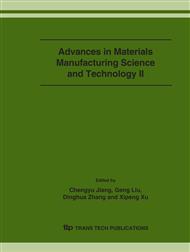p.285
p.289
p.293
p.297
p.301
p.305
p.309
p.313
p.317
The Influence of Acoustic Cavitation to Microscopic Material Removal in Polishing Process Based on Vibration of Liquid: A Numerical Study
Abstract:
In Polishing Process based on Vibration of Liquid (PVL), abrasive particles driven by polishing liquid will brush and etch workpiece to achieve material removal. Because the liquid is vibrated in ultrasonic frequency, polishing process will be greatly affected by cavitation phenomenon. The critical thermal conditions and high-speed liquid jet produced by bubble dynamics may damage workpiece. A refined Dissipative Particle Dynamics method is applied to study the effect of acoustic cavitation on PVL. Validity of the numerical simulation is tested according to experimental results.
Info:
Periodical:
Pages:
301-304
Citation:
Online since:
December 2006
Authors:
Price:
Сopyright:
© 2006 Trans Tech Publications Ltd. All Rights Reserved
Share:
Citation:


